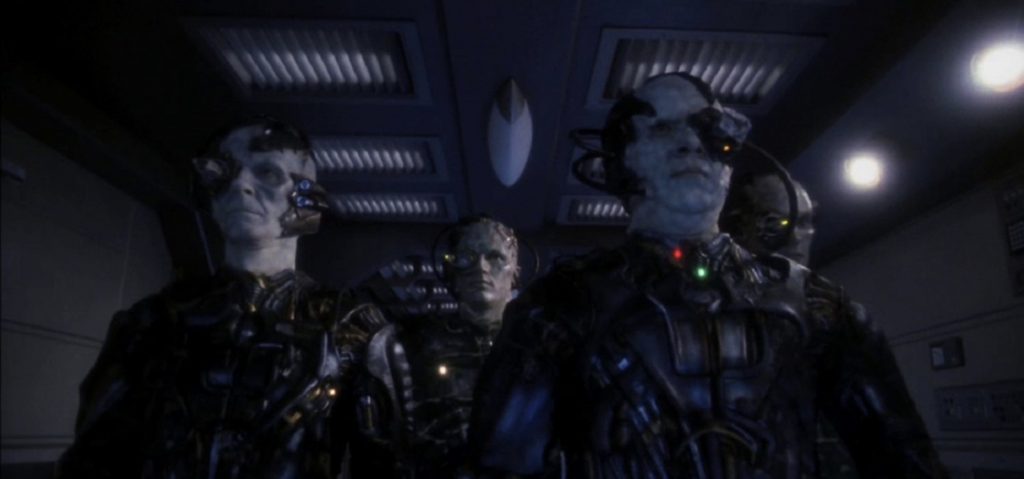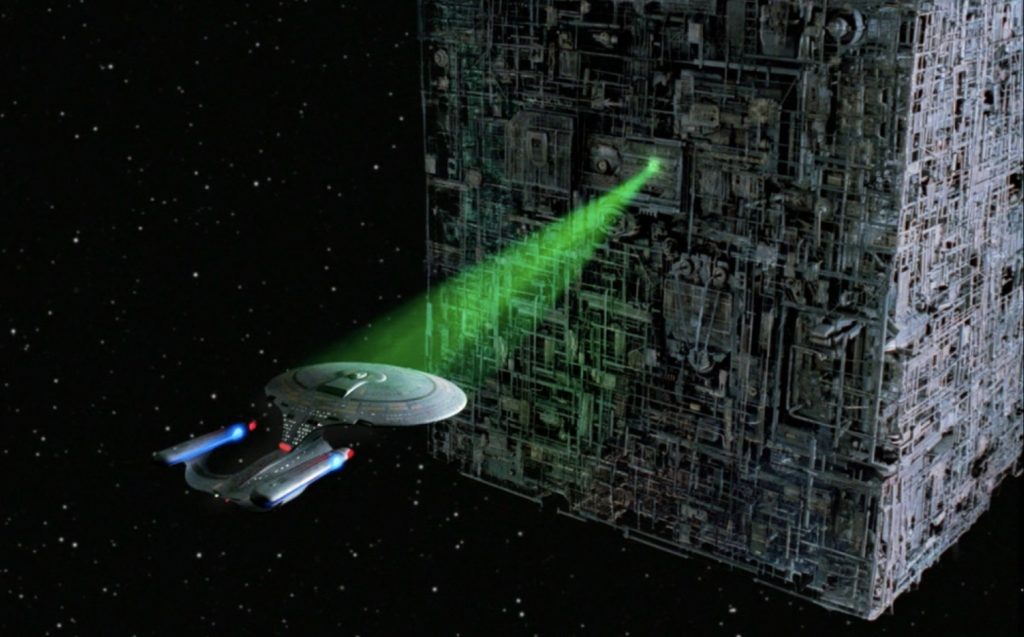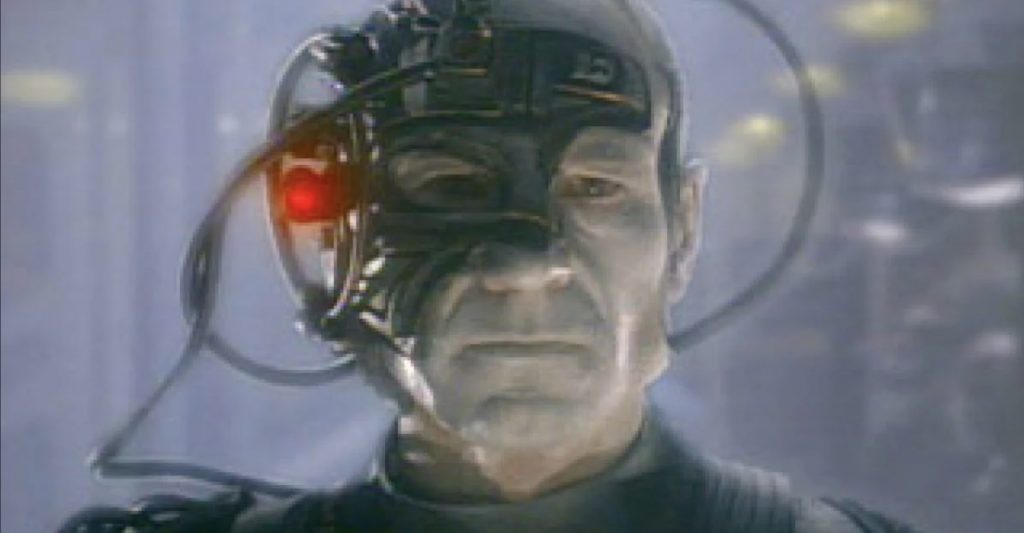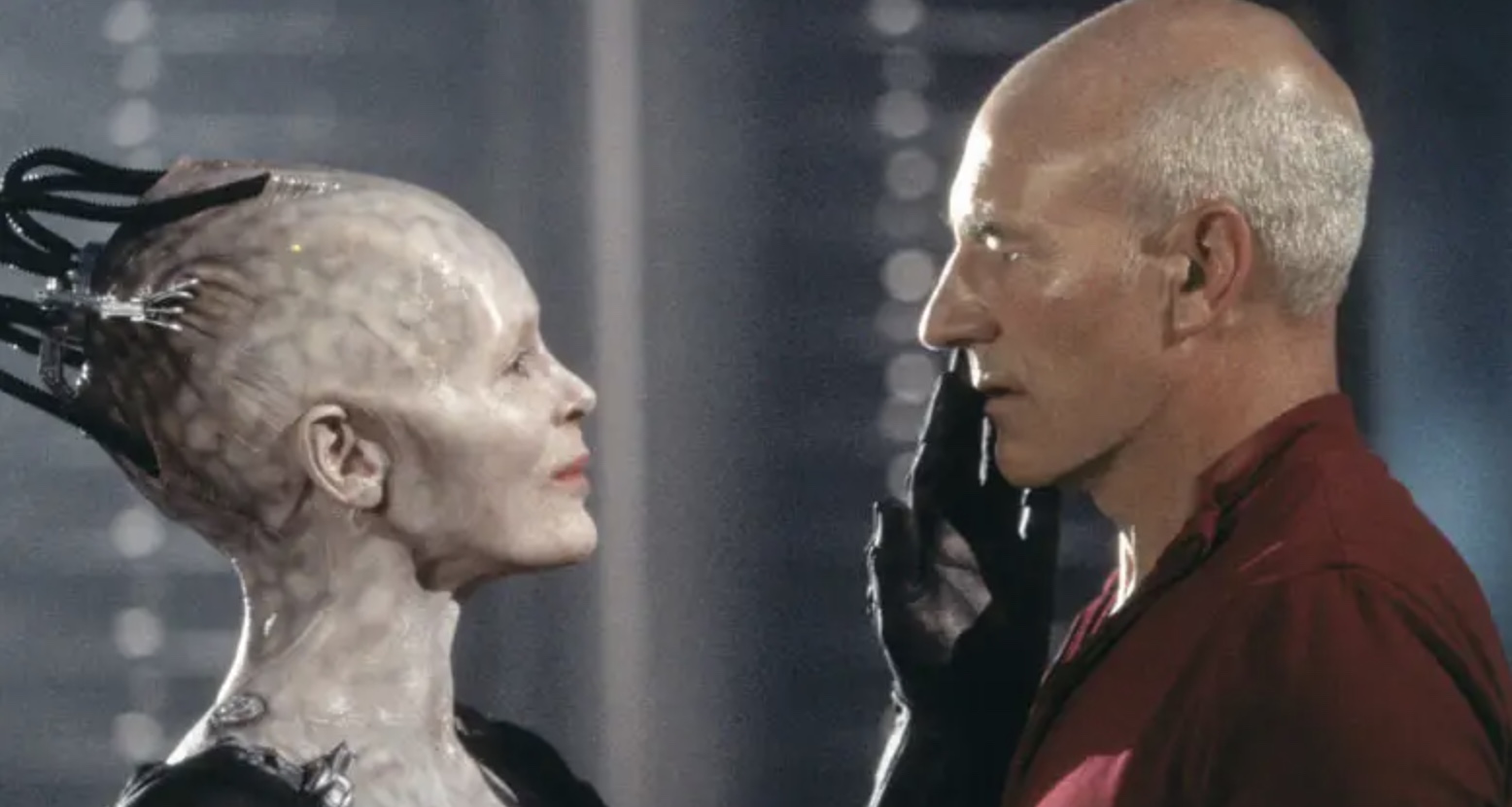Core Data:
- Vision: a mutually dependent hive of cybernetic organisms known as the Borg
- Type: Popular culture – films and TV
- As Seen In: Star Trek: The Next Generation, Star Trek: First Contact, Star Trek: Voyager, Star Trek: Enterprise, Star Trek: Picard
- Envisioned: 1989-present
- Visionaries: Maurice Hurley (writer)
- Target Date: 24th century
Overview:
With a Klingon serving on the bridge of the new-look starship Enterprise, Star Trek: The Next Generation had to look beyond the original series for its lead villains. The Ferengi were originally lined up to assume the mantle in the spin-off show, but the diminutive capitalists were ultimately too comedic to be a realistic threat to the Federation.
The antagonist deficit was spectacularly rectified in season two episode ‘Q Who’, however, when omnipotent trickster Q transported Captain Jean-Luc Picard and his crew to the other side of the galaxy. This was our introduction the crew to Starfleet’s greatest ever foes: the Borg.
This cybernetic race, organic beings enhanced with technological implants, were unlike anything we’d seen before. Travelling around in vast, ruthlessly functional cube spacecraft, the Borg consisted of legions of personality-free drones, all working together as a single hive mind. But most chilling of all, this new foe’s sole reason for being was assimilating other cultures and technologies into their Collective. As they were so fond of reminding us, resistance is futile…

Key Tenets:
- Hardware: The bodies of humanoid species are augmented with numerous cybernetic augmentations. These usually include an eye implant to enhance the Borg’s vision, and arm prostheses which have multiple uses, including interfacing with computers.
- Babies are born in artificial maturation chambers. Soon after birth, they start receiving implants that will turn them into Borg drones.
- When grown-up individuals are turned into drones, the assimilation process starts with the injection of nanoprobes. Once introduced to the bloodstream, these microscopic machines start to integrate with the host’s cells on a genetic level.
- The nanoprobes also give the new Borg their characteristic pasty complexion.
- Borg technology enhances the individual’s biology, giving them improved strength and dexterity.
- Once implants have been installed, they cannot be safely removed from the host unless deactivated. Even then, some components become so integral to a Borg’s functions that they can’t survive without them. This is why Seven of Nine, a former member of the Collective, retains some of her Borg augmentations long after she’s regained her humanity.
- A Borg drone is in constant communication with all the other members of the Collective. This subspace network (essentially fancy wifi) allows the Borg to think as one.
- As well as absorbing flesh-and-blood individuals, the Borg will integrate any useful machinery into their Collective – why go to the trouble of inventing a cool new gadget when you can assimilate the tech instead?
- The Borg travel around in vast, utilitarian cubic vessels, based on repeating structures. They do not believe in comfort or interior design.
- If a Borg drone dies, their colleagues remove key components, and they are permanently disconnected from the Collective.
- Experience: Borg drones lose all sense of individuality. They think as one with the other members of the Collective.
- Subsequently, the Borg have a massive problem with singular pronouns – ironically one of the most powerful civilisations in the galaxy can be flummoxed by a simple ‘I’.
- Individuality is such an anathema to the Borg that if a single drone gains a sense of self – as happens in the ‘I, Borg’ episode – the concept becomes a virus capable of bringing down an entire Borg Cube.
- There are exceptions to this rule, however. The Borg Queen is the personification of the Collective, capable of behaving and communicating as an individual.
- The Borg also turned Captain Jean-Luc Picard into Locutus of Borg (in The Next Generation’s best ever episodes, ‘The Best Of Both Worlds’ two-parter), to act as their spokesperson during their planned takeover of Earth.
- The Borg are totally obsessed with assimilating everyone they encounter – and absolutely will not take no for an answer. The only exceptions to the rule are species they believe to be inferior – the Kazon, for example, were deemed to be incapable of enhancing the Collective.
- The Borg do not experience fear. They move at their own pace and will ignore you until they believe you’re a threat.
- When under threat, the Borg work together to make rapid adaptations to their defences and tactics. If one drone dies, chances are the next one will have developed an effective countermeasure (eg enhanced shields) to survive the attack.
- When not active, Borg plug themselves into a designated alcove for regeneration – they sleep standing up.
- During regeneration cycles, Borg with a specific genetic mutation can interact inside a virtual construct known as Unimatrix Zero. Within this metaverse (unknown to the wider Collective) individual drones regain their sense of self.
- Although ruthless and seemingly unbeatable, the Borg’s Achilles heel is Federation starships – the crews of the USS Enterprise and USS Voyager defeat them on a surprisingly regular basis.
- Company: Companies are irrelevant.
- Economics: Economics are irrelevant.
- IP: All intellectual property will adapt to service the Borg. Resistance is futile.

State of Play (March 2022)
- Hardware: Distributed (or shared) computing systems can allow multiple computers to work together to achieve a common goal, such as solving a complex mathematical or scientific problem. Just as the Borg work together to become greater than the sum of their parts, using multiple smaller units in unison can sometimes be preferable to operating a single ‘supercomputer’.
- Like the Borg, computers can stay in constant contact with each other via wired or wireless technology.
- Using nanobots (tiny machines with diameters in the region of 0.000001mm) to take over an entire organism by rewriting their DNA is still, thankfully, in the realms of science fiction. But the application of similar technologies does have potential in real-life medicine, where it’s hoped that nanobots could be programmed to target cancer cells.
- We’re not quite at the point where humans and machines can operate as one – seamlessly transferring data between organic and synthetic components – but neural interfaces are real. Simple EEG headsets can be used to control computers and games, and electronic brain implants are already being used to treat Parkinson’s disease.
- Cybernetic implants still have some way to go before the Borgification of mankind begins in earnest, but some people are already turning themselves into cyborgs (a body with both organic and synthetic components) by choice. This BBC article talks to people who’ve had microchips, magnets and LEDs implanted to “upgrade” their bodies.
- No invasive surgical procedures are required to use them, but smartphones and wearable tech such as smartwatches and Bluetooth headsets perform a similar function to Borg implants, connecting us to collectives of our own.
- Experience: The Borg’s organisational structure owes a lot to certain species of insect – bee hives and ant colonies are often built around a single queen being serviced by thousands of drones.
- We sometimes struggle to move data between different operating systems and platforms, so the idea that the Borg can assimilate any technology in the galaxy may be a little fanciful. Let’s see how they handle Betamax…
- Company: The Borg’s “assimilate this” ethos redefines the idea of a hostile takeover. They will not stop until they control the entire market so, if they existed for real, you’d hope legislation restricting monopolies might hold them back – for a while, at least…
- Economics: The Borg don’t believe in choice, meaning they’re completely at odds with a contemporary economic system that’s largely dependent on giving consumers multiple purchase options.

Reality check: still sci-fi but our Borgification has begun
Cybernetic implants may be basic and niche, and people may still have (at least the illusion of) free will… But the Borgification of humanity is already well under way. Computers and smartphones keep us in constant communication with other members of our communities, while wearable technology such as smartwatches and Bluetooth headsets are effectively a non-invasive version of Borg tech. We’re now cyborgs in all but name – resistance really is futile.
Further reading
A self-confessed full-time geek, freelance journalist Richard has spent most of his career writing about sci-fi and fantasy – including more than a decade on staff for SFX magazine. He's particularly keen on franchises with "Star" in the title.



































